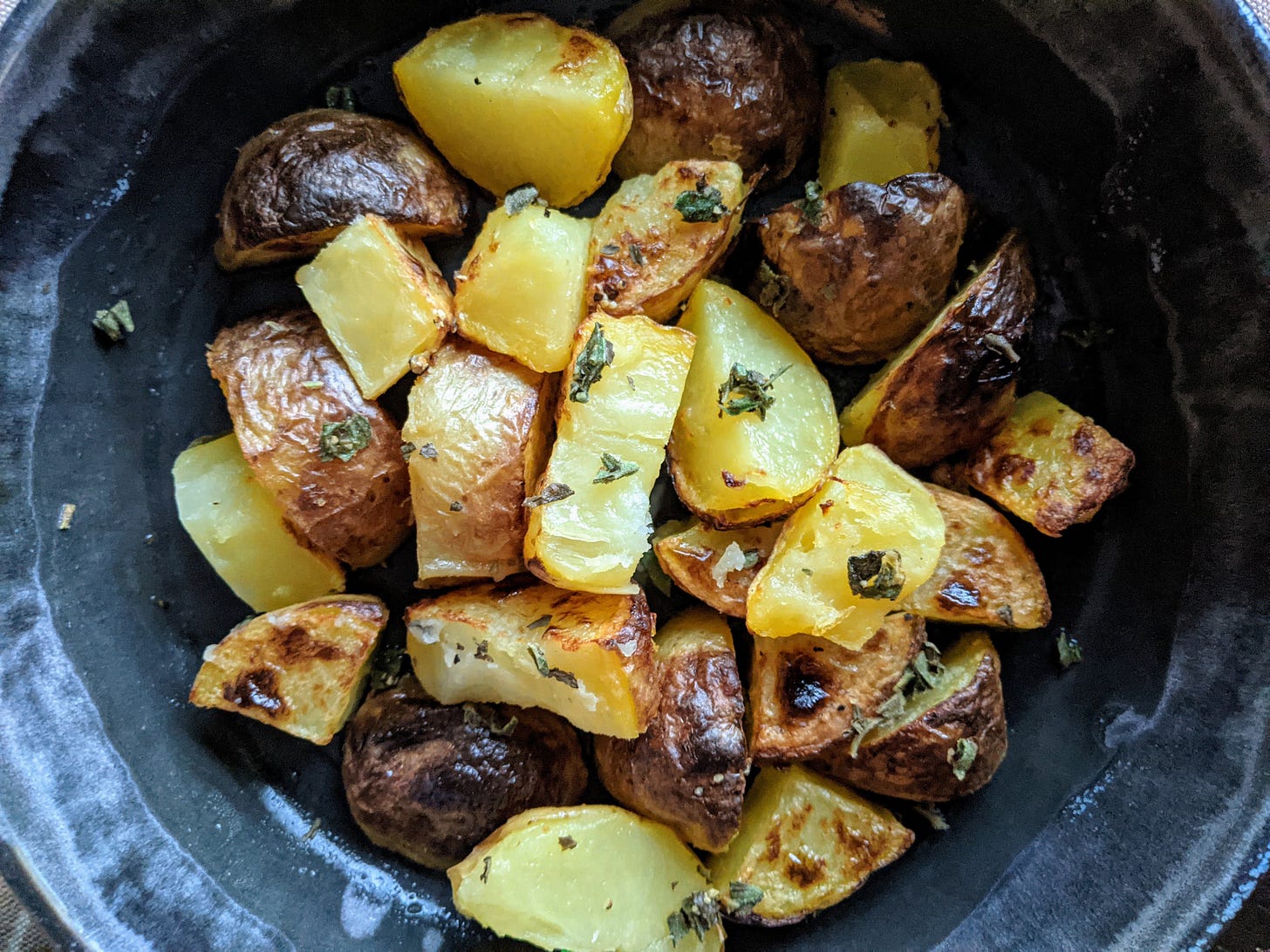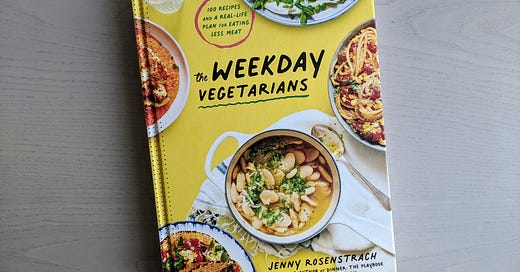Weeknight cooking for the world we live in now
Reviewing The Weekday Vegetarians by Jenny Rosenstrach
Over the past few years, I’ve been trying to internalize that eating meat at the pace I always have, with the frequency I did as a kid, isn’t going to be possible forever. I have this subconscious expectation that at some point in the near-ish future, eating meat all the time is either literally going to be impossible or there will be some kind of societal mandate that we have to stop doing this. And I want to have the chance to work my way up to that change rather than struggling to adjust if or when I no longer have a choice.
A version of that forced shift already happened in my household last year when quarantine began. I am lucky enough not to have been directly impacted by the meat shortages that proliferated the start of the pandemic, but my partner was raised vegetarian, and though he’s been eating meat for several years, the amount I eat it was too much for him once we had to share all of our meals. Luckily, for the previous couple of years I had been making an effort to transition to all vegetarian lunches and get over my dislike of beans, so I wasn’t totally at a loss for planning more vegetarian dinners for us. I’m still eating meat, but it’s only a few times a week instead of every dinner and most lunches as I did just a few years ago.
It’s been a long journey to get here, and maybe things could have moved along faster if I’d had a book like The Weekday Vegetarians available to me from the jump. With recipes that are exciting and approachable, plus tips for developing meal ideas that work for your household, this book is an excellent guide to cutting meat out of your diet in a way that truly feels sustainable.
The Weekday Vegetarians is the fourth cookbook by food writer Jenny Rosenstrach, best known for the family cooking-focused blog Dinner: A Love Story that she’s maintained for over a decade. A few years ago, she and her husband decided to transition their family toward eating less meat by becoming “weekday vegetarians.” Meat eating would be limited to weekends, with the caveat that their teenage daughters could eat whatever they wanted outside the house for breakfast and lunch during the week but would always come home to a vegetarian dinner. With this pledge, Rosenstrach gave herself the challenge of finding vegetarian recipes that would please the whole family—adapting longtime favorites to their new lifestyle and developing strategies that would make the transition easier. She describes her recipe approach as “strategic, healthy, creative, and—most important—realistic...I know by now that we’re not going to win anyone over to our weekday meat-free side with complicated recipes that require cooks to break out a small army of appliances on a Tuesday night.”
The result is a wide variety of recipes that come at vegetarianism from multiple angles. The book kicks off with easy to love pizzas, and includes customizable bowls, filling multi-component salads, tortilla-based dishes, noodle ideas, and skillet mains. A whole section is dedicated to small plates with a structure for creating a balanced and filling meals from them: one bean dish, one bread, and a few vegetable sides. Finally, there’s “The Vegetarian’s Very Special Bag of Hooks and Tricks,” filled with protein hits like crispy chickpeas and softboiled eggs; exciting condiments and dressings; and easy bread recipes to draw family to the dinner table.
It was super easy to find ideas in this book that appealed to me and my partner, which is not always as straightforward as one would hope. We ended up making four dinners from the book over two weeks, as well as turning to its sauce recipes to tszuj up sides we were eating with meat dishes. The biggest standouts, which I’m sure I’ll return to for many meal plans to come, were the Eggplant and Tofu with Sweet-Hot Chili Glaze and the Broiled Caesar Salad with Chickpeas.
I’m far enough along in my “eat less meat” journey that I don’t automatically shy away from tofu. The first time I the dish was at a Japanese restaurant in the West Village that was known for making tofu in-house, serving it warm and freshly scooped, which allows you to fully appreciate its silky texture and custardy, toasty flavor. Although I wouldn’t start cooking tofu for years after that, the experience enabled me to appreciate it for what it was and not eat it wishing it was chicken. Eventually I started learning how to prepare tofu for stir fry and am now genuinely excited to have it for dinner with good sauces and fluffy white rice, so the Eggplant and Tofu in The Weeknight Vegetarians was right up my alley. I’m used to shallow-frying tofu for this kind of dish, but this recipe has you toss it with oil, cornstarch and soy sauce and bake it on a sheet pan along with similarly-prepared eggplant, which was a lot faster and less messy. Once browned in the oven, it all gets tossed in a Sweet-Hot Chili Glaze that is essentially buffalo sauce (hot sauce + melted butter) with brown sugar added. Obviously, it was delicious, and I can imagine this converting a tofu skeptic. (Also, the leftover sauce made a killer glaze for grilled corn the following week.)
Our other fave was the Broiled Caesar Salad with Chickpeas. Caesar salad with crispy chickpeas is already a go-to in our household, but we loved this variation. Traditionally we make our Caesar dressing from scratch, but we always end up with a substantial amount of leftover dressing because it’s hard to reduce a recipe built on egg yolk. Rosenstrach’s method does away with that problem entirely because you just start with a few tablespoons of mayonnaise and add the Caesar ingredients (mustard, white wine vinegar, lemon juice, etc.) from there. You then brush the dressing onto halved romaine hearts, sprinkle with parmesan (technically not vegetarian, which she admits), and broil for a few minutes until the lettuce is attractively browned and shriveled. The crispy chickpeas, which are just fried or roasted in oil and then tossed with a mix of paprika, garlic powder, and cayenne, go on top with scallions or red onion plus more dressing and parmesan. The cooked romaine still holds its crunch while having melty areas infused with the dressing, and the spicy chickpeas and bite of the scallion balance out the overall creamy richness for a really excellent dinner.

We also made a great meal of the Zucchini Pizza, which is topped with shredded zucchini, garlic, mozzarella, parmesan, ricotta, and fresh herbs; pairing it with the book’s Greek-Style Lemon Oregano Potatoes. Rosenstrach said it made her household of zucchini haters rethink their position, but my partner and I are firmly in the “zucchini tastes like water” camp and there were so many other great things going on with this pizza (including the fact that I doubled the garlic) that the zucchini didn’t really add anything other than the suggestion of healthiness. I also have to call out how weird it is that a book with a whole section dedicated to pizzas doesn’t have a pizza dough recipe, but since the book is geared toward weeknight cooking I guess it’s fair for Rosenstrach to assume you’ll just buy premade dough. (We turned to the Cheeseboard: Collective Works pizza dough recipe which was fantastic. Here’s another one we normally use which is more easily accessible.)

The only recipe that was a miss for me was the Pizza Salad with White Beans, a concoction of Bibb lettuce, tomatoes, red onion, mozzarella balls, basil, parmesan, and croutons with the book’s recipe for Marinated Beans. The salad is supposed to be dressed by the addition of the beans with their red wine vinaigrette marinade, but it wasn’t enough, and the Bibb lettuce collapsed under the weight of all the wet ingredients in a way that was unappealing to me. I would give this another shot with a hardier lettuce (using up leftover romaine from a Broiled Caesar maybe?) and more dressing, though.
Overall, some of the recipes in this book can be a bit fussier than I would normally expect for a weeknight meal, and I would say that having a cooking partner was essential to getting through them efficiently. But, there’s a reason behind all the components: one of the book’s recommendations for transitioning to vegetarianism is zeroing in on the most beloved dish components in your household and using them to make a meal more approachable. Ingredients like the mouthwatering Sweet-Hot Chili Glaze, perfectly salty spicy Crispy Chickpeas, and dollops of ricotta on the Zucchini Pizza really do make dishes more enticing, lowering the barrier for entry to move away from meat. And the general idea of paying close attention to the individual elements that make us excited to eat something is going to make a major impact on our meal planning from now on—I’m convinced I can get myself into tempeh and seitan if I just find the right sauce!
My partner was surprised that I was so into this book when he saw how many meat replacements there are, such as panko breaded tofu cutlet sandwiches and the dreaded cauliflower steak, which is not my usual cup of tea—let tofu be tofu and cauliflower be cauliflower! But I can appreciate it in the context of Rosenstrach’s effort to convert a whole household of meat eaters to the world of veg. As she explains in the intro, “going vegetarian doesn’t mean anyone has to give up their favorite dish...just some of the ingredients involved in making that dish.” She is throwing out every strategy she can to help you figure out a plan for eating less meat that really works for the captive audience at your dinner table, and I have to applaud that. No matter where you’re coming from, I believe that The Weekday Vegetarians has at least one idea that could make cutting out meat feel like a doable lifestyle change rather than a well-meaning resolution that collapses under pressure. And couldn’t we all use that kind of non-judgmental, encouraging guide?
Next issue: I’m not sure! I’m going to be moving to a once a month schedule for this newsletter so it’ll be a bit until you next hear from me.





